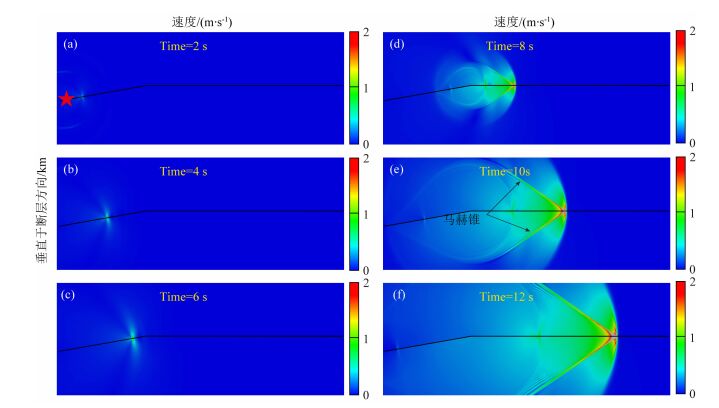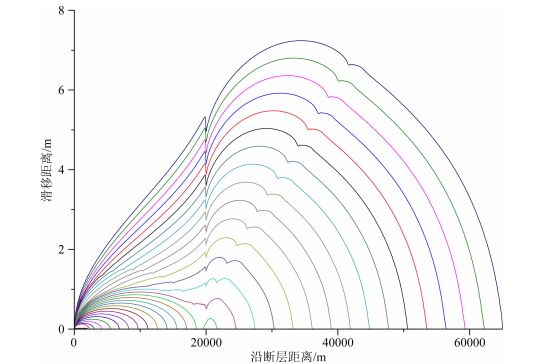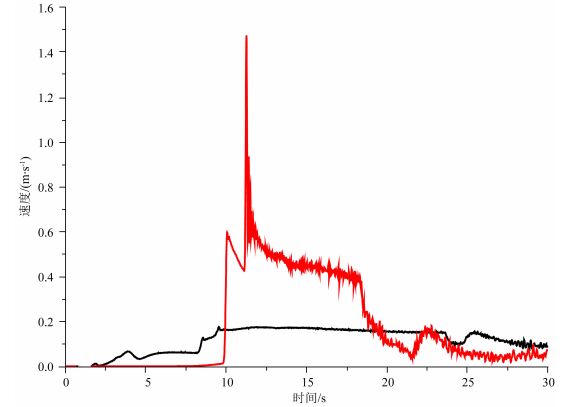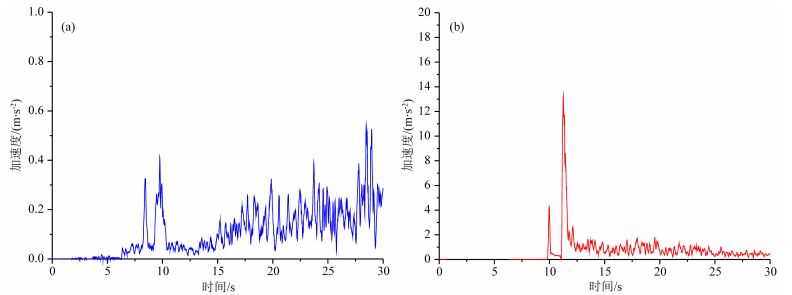2. 中国科学院计算地球动力学重点实验室, 北京 100049
2. Key Lab of Computational Geodynamics, Chinese Academy of Sciences, Beijing 100049, China
2010年4月14日,青海省玉树藏族自治州发生了强烈地震(称为玉树地震).据中国地震台网测定,玉树地震的震中位置是33.11°N、96.59°E,震级为MS7.1,震源深度是14 km.本次地震造成的灾害十分严重,尽管地震位于青藏高原腹地,人烟稀少,但仍造成了3000余人死亡或失踪.与同等震级的地震相比,玉树地震的灾害明显加重.出现这种现象的原因可能是该地震的震源过程产生了超剪切破裂现象(如:Wang and Mori, 2012; Yokota et al., 2012;张丽芬等,2014; Yue et al., 2013; Huang et al., 2016).类似于超音速飞机飞行时产生音爆,超剪切破裂的地震会在地面产生地震冲击波(seismic shock wave),加重地震的破坏作用(Bouchon and Karabulut, 2008).
一般情况下,绝大多数天然地震其震源破裂过程都为亚剪切破裂(断层破裂前端的扩展速度小于介质的剪切波速度).自从1973年Burridge(1973)从理论上预测裂纹的破裂速度可以大于介质的剪切波速度(即发生超剪切破裂)以来,全球除玉树地震外已经发现了多起地震事件产生了超剪切破裂现象,如:1979年美国Imperial Valley地震(MW=6.5)(Archuleta, 1984; Spudich and Cranswick, 1984),1999年土耳其Izmit地震(MW=7.6)(Bouchon, et al. 2001; Bouchon et al., 2002; Sekiguchi and Iwata, 2002),1999土耳其Düzce地震(MW=7.1)(Bouchon et al., 2001; Birgören et al., 2004; Bouin et al., 2004; Konca et al., 2010),2001年中国昆仑山口西地震(MW=7.8)(Bouchon and Vallée, 2003; Antolik et al., 2004; Robinson et al., 2006; Vallée et al., 2008; Walker and Shearer, 2009),2002年美国阿拉斯加Denali地震(MW=7.9)(Dunham and Archuleta, 2004; Ellsworth et al., 2004; Asano et al., 2005; Walker and Shearer, 2009)以及2013美国阿拉斯加Craig地震(MW=7.5)(Yue et al. 2013).
当发生超剪切地震破裂时,不同时刻所有破裂尖端产生的地震波同时到达马赫锥(见图 1),并发生相长干涉,导致马赫波振幅显著增大,相应的地震动幅度也大大增加,从而加重地震灾害(Bernard and Baumont, 2005; Dunham and Bhat, 2008;Andrews, 2010; Cruz-Atienza and Olsen, 2010;Vallée and Dunham, 2012;Yue et al., 2013).可见,超剪切破裂使得玉树地震造成的地震灾害比同等震级的地震要严重得多.

|
图 1 断层发生超剪切破裂产生马赫波的示意图 图中粗线代表断层破裂面,箭头表示破裂传播方向.当断层破裂速度(Vr)大于介质的剪切波速度(Vs)时,产生超剪切破裂,形成马赫波.其波阵面是一个锥面,称为马赫锥,半锥角α称为马赫角(α=arcsin(Vs/Vr). Fig. 1 The diagram of shear Mach waves for a supershear rupture The bold lines represent fault interfaces, and the arrow indicates rupture propagation direction. When rupture velocity is greater than the shear wave velocity (supershear), Mach wave will occur, and the wave front is a cone, called Mach cone. The semi-cone angle α iscalled Mach angle (α=arcsin(Vs/Vr), where Vs is shear wave velocity, and Vr is rupture velocity. |
通常,发生超剪切破裂的地震其发震断层空间展布有一定的特征,就是断层几何形状简单,在空间不间断、连续、断层平直,并且断层长度要足够大.这样,亚剪切地震破裂才能逐渐得到加速过渡为超剪切破裂(Dunham et al., 2003; Xia et al., 2004; Das, 2007; Robinson et al., 2010; Bouchon et al., 2010; Mello et al., 2010).但是,经考察发现玉树地震的发震断层由长度较短的不同断层段组成并在空间发生弯曲(拐折)(见图 2),因此,与通常产生超剪切破裂的断层几何条件不是非常吻合.那么,玉树地震为什么能产生超剪切破裂?其中的物理机制又是什么,是哪些因素造成了玉树地震的超剪切破裂行为?

|
图 2 玉树地震震中及周边地质构造图.图中粗实线表示玉树地震的发震断层,由2段组成,其夹角约为10°.震中位于隆宝湖附近的断层段(发震断层西段),宏观震中在发震断层东段的郭央烟宋多地区 Fig. 2 Geological map in and around the epicenter in the Yushu earthquake.Bold solid lines represent seismogenic faults, consisting of two segments, and there is an intersection angle of 10° between them, forming fault bent |
这些问题至今还不太清楚,但这些科学问题的研究对于认识震源过程、评估地震灾害等有着非常重要的理论意义与实际应用价值.本文将根据玉树地震的发震构造以及周边的地质、应力场等环境,利用有限元模拟方法,定量研究玉树地震产生超剪切破裂过程的物理机制.
2 地震构造背景与有限元模型 2.1 构造背景2010年玉树地震位于鲜水河断裂带西段的甘孜—玉树断裂上,该断裂以左旋走滑运动为主,全长约300 km, 总体走向为NW-NNW.甘孜—玉树断裂带自第四纪以来活动非常强烈,近代就发生过多次强烈地震,有历史记录的大地震包括1320±65年竹庆—日阿附近8.0级地震、1738年玉树西北7.5级地震、1854年甘孜7.1级地震和1896年邓柯7.5级地震(周荣军等,1997).
震后地质调查表明,玉树地震主震导致了长约65 km的东、西两条地表破裂带,破裂带走向为310°,呈现左旋走滑性质.西段破裂带分布在震中附近的隆宝湖拉分盆地中,长约19 km; 东段破裂带沿扎曲河南岸及巴塘河西岸山坡展布,长度约31 km; 上述两条破裂带之间存在约15 km的地表破裂空区.最大同震位移量为2.3 m,位于东段地表破裂带中部郭央烟宋多附近(宏观震中),也是地震灾害最为严重的区域(如:马寅生等,2010;张永双等,2010;潘家伟等,2011;吴富峣等,2011).
许多学者根据地震波及大地测量等资料,对玉树地震的震源破裂过程进行了反演.张勇等(2010)利用垂向P波记录,反演给出了玉树地震的破裂过程,大体如下:1) 该地震总体上是一次单侧破裂事件,破裂从震源位置开始,主要向震中东南方向扩展;2) 地震由两次子事件组成,分别对应于震中附近以及震中东南方向上.Wang和Mori(2012)利用地震波资料反演给出,玉树地震破裂开始是亚剪切破裂,然后加速成为超剪切破裂.徐彦等(2011)、张丽芬等(2014)利用地震波资料反演了玉树地震的破裂过程,结果显示玉树地震震源破裂时间为20 s,破裂尺度为60 km.在玉树地震的整个破裂过程中能量主要在两个时间段和空间上释放.一个能量释放点是震后6 s,位于震中附近;另一个是震后12 s,位于震中位置东南,靠近结古镇的区域,且第二次能量释放是玉树地震破裂过程中能量最大的,破裂速度达到4.7 km·s-1, 产生了超剪切破裂.王洵等(2014)利用地震波形和InSAR资料,反演了玉树地震的断层破裂过程,发现主破裂由2次事件构成,这2个事件发生在不同的断层段,并且这两个断层段的走向有所不同.同时,Li等(2011, 2012)、Sun等(2013)和Jiang等(2013)利用InSAR等资料反演给出的同震破裂面,也是由走向不同的断层段所组成.
综合以上地质、地震及大地测量方法给出的对玉树地震破裂过程的研究结果,破裂过程的总体特征是:玉树地震成核于隆宝湖(震中)附近的断层段(断裂带西段),整个断层破裂由西向东呈单侧破裂的特征,破裂带由走向不同的两个断层段构成(见图 2),在宏观震中的郭央烟宋多附近所在的断层段出现了超剪切破裂.
2.2 有限元模型根据玉树地震所在区域的地质构造、应力场状态以及介质物理性质等构造有限元模型.模型中,断层几何为图 2中所示的粗实线.文中通过计算玉树地震断层的自发破裂过程,来考察超剪切破裂产生的物理机制.
2.2.1 模型几何及边界条件为分析断层段的走向不同(断层拐折)对断层破裂传播速度的影响,定量分析断层拐折是否有利于断层破裂由亚剪切转化为超剪切破裂.我们根据玉树地震的实际发震断层构造建立了由2条走向不同的断层段组成的断层系统.为了抓住主要矛盾,便于研究断层拐折对断层破裂速度的影响,我们将实际断层的三维情况简化为二维的概念模型,并将断层简化为2条直线(图 3中直线AB和BC).图 3为有限元模型几何及初始、边界条件示意图.由图可见,模型空间尺度为100 km×100 km的正方形,直线AB表示隆宝湖地区所在的断层段,直线BC表示郭央烟宋多地区所在的断层段.断层段AB与BC之间的夹角为10°.此外,震源(破裂的起始位置)位于断层段AB上,而宏观震中所在地区的郭央烟宋多位于断层段BC中央附近.参照前人的研究方法(如:Shi et al., 2008;Olsen-Kettle et al., 2008;袁杰和朱守彪,2014a; 2014b; 2017),通过破裂成核来实现断层的自发破裂过程.模型在断层段AB上设置了成核区(图 3中的黑色小方块),这段区域的应力状态在破裂开始前就已达到或超过破裂准则所要求的临界状态,其长度为2 km.为防止地震波通过边界反射而影响计算结果,模型在四周设置了吸收边界(图 3中的灰色部分).此外,初始应力状态对于断层破裂过程起着非常重要的作用,因此模型中初始应力大小依据前人的做法来选定(如:Kaneko and Lapusta, 2010; 袁杰和朱守彪,2017).另一方面,最大主压应力方位与地震震源机制解P轴方位并不完全一致,一般相差6°~10°(王连捷等,2011).因此,模型中施加的最大主压应力方位与BC断层段的夹角为68°,与AB段的夹角为58°.这样加载到模型边界上的初始正应力与剪切应力方向见图 3,具体数值大小见表 1.

|
图 3 有限元模型及初始、边界条件示意图 模型几何为100 km×100 km的正方形.AB、BC分别表示2条断层,其走向不同,夹角为10°.黑色小方块表示成核区,P1、P2表示虚拟接收台站位置. Fig. 3 Model geometry, the initial and boundary conditions The model domain is 100 km by 100 km. Lines AB and BC in the figure represent the two segments of the faults, which strike in different directions, and the angle between the two segments is 10°. The squre patch stands forthe location of the nucleation zone. The triangle marks, P1 and P2, denote virtual seismostations. |
|
|
表 1 模型中的材料参数、初始应力场及摩擦系数 Table 1 Model material parameters, initial stress field and friction coefficients |
研究中利用ABAQUS/Explicit商业有限元软件(有限元显式计算程序)(Hibbitt et al., 1997)来模拟断层破裂的动力学过程.模型全部采用3节点单元来剖分,以此来消除沙漏现象对模型计算产生的影响(Hibbitt et al., 1997).由于断层为研究的重点区域,为保证计算精度又能提高计算效率,对断层区域的网格进行了细化(单元边长为50 m),但随着离开断层距离的增加,单元的尺度会越来越大,模型最外围部分单元的边长为500 m.这样整个模型的有限单元节点数为301343,单元数为597675.模型四周的吸收边界采用的是无限单元(Hibbitt et al., 1997;袁杰和朱守彪,2017).
为简单起见,模型中的介质选取为均匀各向同性的线弹性材料,具体的材料参数、初始应力场大小及摩擦参数等见表 1.此外,在有限元模拟中,计算的时间步长取为10-4 s.
2.2.2 摩擦本构关系摩擦关系对断层破裂方式及其随时间的演化过程起着非常重要的作用.本研究参照前人的做法,选择滑移弱化的摩擦本构关系(Ida, 1972; Palmer and Rice, 1973; Andrews, 1976a; 1976b; Weng et al., 2015;袁杰和朱守彪,2017).其数学表达式如下:

|
(1) |
式(1) 中μs为静摩擦系数,μd为动摩擦系数,|s|为断层面上两点之间的相对滑动距离(位错),Dc为特征滑动距离.实际计算中,这些参量的具体数值大小见表 1.
3 模拟结果上述有限元模型中,一旦破裂在震源所在的断层上成核,就立即自发地向断层两侧发生破裂,然后向外传播.下面将详细考察破裂在传播过程中,破裂速度的变化,分析玉树地震产生超剪切破裂的物理机制.
3.1 断层破裂速度在断层拐折处发生变化图 4是有限元模型模拟给出的断层在破裂过程中产生的地震波在介质中传播时,介质质点振动速度云图在不同时刻的快照.从图 3a(起始破裂后第2 s)、图 3b(第4 s)及图 3c(第6 s)展示的云图可以看出,破裂在断层段AB上成核后自发地传播,破裂前端还没有到达断层段之间的拐折之处.从图中显示的破裂速度可知,破裂传播速度低于周围介质剪切波的传播速度.图 3d(第8 s)给出的快照表示破裂已经越过了断层拐折,在新的断层段BC上传播时质点振动的云图.图中清晰地显示了马赫波.后面的图 3e)及图 3f分别是震后第10 s及第12 s时介质振动速度云图;图中的马赫锥也清晰可见.因此,由图 3可知,破裂在断层段BC上传播与在AB上传播具有完全不同的破裂特征,在BC段上出现了清晰的马赫锥,但破裂在AB段上传播时则没有出现马赫锥.对照图 1,我们容易知道,破裂在断层段BC上是以超剪切波速度传播的,但在AB段尚是以亚剪切波速度传播.纵观图 3中的6幅不同时刻的快照,玉树地震的破裂由2次事件组成,断层拐折是2次事件的分界线.在断层拐折以西的AB段上的破裂事件为亚剪切破裂,在断层拐折以东的BC段上的破裂事件是超剪切破裂,这2次事件的破裂特征有显著的不同.因此可以看出,断层拐折是破裂速度由亚剪切波速度向超剪切波速度变化的分水岭,断层拐折对破裂速度变化起着非常重要的作用.

|
图 4 断层破裂过程中,不同时刻介质振动速度云图 黑色直线表示断层所在位置,红色五角星表示成核位置.可以看到图(d)、(e)、(f)中存在明显的马赫锥,说明这时的断层破裂是超剪切破裂(对照图 1);但是在图(a)、(b)、(c)没有见到马赫锥,由此说明断层拐折对于产生超剪切破裂具有重要作用. Fig. 4 Coutour distributions of particle velocities at different times The black lines stand for the location of faults, and the red star denotes the nucleation zone. Clearly, Mach cones are seen in the figures (d), (e) and (f), and not seen in figures (a), (b) and (c), showing the supershear ruptures are produced when the rupture crosses the fault inflection (referring to Figure 1). It is suggestedthat fault inflection play an important role in producing supershear ruptures. |
断层在破裂过程中,断层面上会出现相对滑移(位错);位错大小及其随时间的演化过程受多种物理因素控制(袁杰和朱守彪,2014a; 2014b;2017).图 5展示了断层在整个破裂过程中,断层面上位错的空间分布及其随时间的演化(相邻等值线之间的时间间隔为0.5 s).由图可见,破裂从成核开始传遍整个AB断层段,一共需要大约6.8 s的时间;破裂传播速度约为2647 m·s-1,低于介质剪切波速度(3333 m·s-1),因此属于亚剪切破裂.但是,BC段上破裂传播速度约为5714 m·s-1,显然为超剪切破裂.该数值与利用地震波资料反演的超剪切破裂速度相当(Wang and Mori, 2012; 王洵等,2014).同时,图中显示断层面上任意点的位错是随着时间的推移而不断增加的,说明模拟给出的破裂行为属于裂纹型破裂(crack-like)(袁杰和朱守彪,2014a; 2014b;2017).此外,图 5还显示,断层段BC上的位错量远远大于AB断层段上的数值,这也是导致在BC断层段附近震害比震源所在地区大的原因之一.图 5的位错时空分布告诉我们,破裂在AB断层段上为亚剪切破裂,越过断层拐折后破裂特征发生了变化,转换为超剪切破裂.当发生超剪切断层破裂时,其位错量也比亚剪切破裂时要大.

|
图 5 断层两侧相对滑移距离(位错)随时间的分布 图中水平轴表示沿断层的距离(绘图时将断层拉直),纵轴表示滑移距离.等值线之间的时间间隔都为0.5 s. Fig. 5 Snapshots of the slip profiles along the interfaces various times The horizontal axis represents the position along the strike, and ordinate denotes the slip. The time interval between two adjacent contour lines is 0.5 s. |
为研究超剪切破裂造成地震灾害大大增加的原因,下面考察断层附近的P1、P2两个代表性台站(具体位置见图 3)记录的质点运动速度和加速度情况.P1、P2两个台站分别布设在断层段AB及BC的中央,距离断层都是5 km.由于P1台的位置距离断层段AB很近,因此所记录的结果反映的应该是地震破裂为亚剪切情况下地震波造成的地面运动速度和加速度情况.同理,P2台记录的是超剪切地震破裂产生的地震波结果.图 6展示了P1、P2两个台站记录的质点振动速度(绝对值)随时间变化的曲线.由图可见,P2台记录的速度振幅远远大于P1台的结果,说明超剪切破裂产生的地震波其速度比亚剪切情况要大得多.同样,图 7显示的是加速度(绝对值)记录结果.同速度记录的结果类似,P2台记录的加速度其峰值达到14 m·s-2, 而P1台记录的加速度,峰值大约为0.6 m·s-2.所以,当断层破裂为超剪切时,产生的地震波无论是介质质点振动速度还是加速度都比没有产生超剪切时要显著增大,这可能是造成玉树地震比同等震级的地震灾害严重的重要原因.由于BC断层段附近的加速度远远大于AB段附近的加速度,由此会导致BC段附近的地震烈度会显著大于AB段附近,这样BC段附近的地震灾害会比AB段显著增强,从而造成了玉树地震的宏观震中与实际震中不一致.

|
图 6 两个接收台站(P1、P2) 所记录的质点速度(绝对值)大小随时间的变化.红色曲线代表P2台记录的结果,黑色曲线是P1台记录的结果(台站位置见图 3) Fig. 6 Velocities (absolute value) recorded at two virtual seismic stations (P1 and P2) vary with time. Red curve represents results recorded at P1, and black one at P2. The locations of seismic stations are shown in Fig. 3 |

|
图 7 两个接收台站(P1、P2) 所记录的质点加速度(绝对值)大小随时间的变化曲线(台站位置见图 3) (a) P1台记录的结果; (b) P2台记录的曲线. Fig. 7 Accelerations (absolute value)recorded at two virtual seismic stations (P1 and P2) vary with time (a) Results are recorded at P1;(b) Curves are recorded at P2. The locations of seismic stations are shown in Fig. 3. |
为进一步考察断层拐折对产生超剪切破裂的作用,文中将构建一个新的模型.在新模型中,将图 3所示的模型里的断层面拉平,变成一个平面断层(断层没有拐折),另外让其他所有的模型参数(如:初始应力场、边界条件,物质属性、摩擦关系等)都保持不变.然后,利用新模型来重新计算破裂成核后断层的自发破裂过程.图 8给出了在这个新模型里,不同时刻介质振动速度的云图.但我们从这个图上没有见到像图 4中所示的马赫锥,说明在这种情况下,没有产生超剪切破裂.因此,证明了断层拐折对于产生超剪切地震破裂的必要性与重要性.

|
图 8 当2段断层在同一平面内时,模型计算的不同时刻速度云图.对照图 4可知,此时不产生超剪切破裂 Fig. 8 Snapshots at different times when two fault segments are in one plane or line It is clearly seen that it is no supershear rupture referring to Fig. 4 |
另外,仅仅具有断层拐折的断裂系统,并非都一定能产生超剪切地震破裂.我们对于图 3所示的模型,改变初始应力场的大小(等效于将最大主应力方位发生变化).通过计算发现在一定条件下,断层拐折不仅不能产生超剪切地震破裂现象,通常还会阻止断层破裂继续传播,断层拐折可能导致破裂终止.所以,初始应力场中主应力方位与断层走向的夹角以及断层走向变化的角度必须要满足一定的数量关系,只有它们配套到恰到好处,才有可能产生超剪切地震破裂.由于满足这样的条件比较苛刻,所以天然地震中发生超剪切地震破裂的现象并不多见.
此外,袁杰和朱守彪(2017)分析了断层阶区可以促进超剪切破裂现象的产生.对玉树地震的震后地质调查也确实发现,玉树地震中的发震断层也有可能存在断层阶区,那玉树地震的超剪切破裂是否与断层阶区有关?我们进行了模拟实验,发现断层阶区在促使断层破裂由亚剪切转变为超剪切破裂时,需要一定的时间停留来积累能量,即断层破裂过程中有短暂的停顿现象.对于玉树地震这样的断层系统,若考虑断层阶区的影响,破裂暂停的时间在10 s以上.但测震学观测以及前人反演的地震破裂结果都不能支持断层破裂暂停的假定.所以,玉树地震的超剪切破裂不能归属于断层阶区的作用.
产生超剪切破裂还有一个重要影响因素就是自由表面效应.数值模拟结果显示,在滑移弱化的摩擦关系下,自由表面可以让以亚剪切波速度传播的破裂转换为超剪切破裂(如:Olsen et al., 1997; Dunham, 2007; Kaneko and Lapusta, 2010).但由于地表附近介质比地下深部介质软弱,地表附近应力状态也不同于地下深处;同时,近地表断层破裂的摩擦关系可能是速度强化的(velocity-strengthening).这些因素都不利于地表产生超剪切破裂,这也可能是我们见到的大多数走滑型地震,尽管破裂通常都到达了地表,但并没有观测到产生超剪切破裂现象(Kaneko et al., 2008; Kaneko and Lapusta, 2010)的原因.同时,玉树地震地表破裂带出现了空段,说明自由表面效应对于玉树地震产生超剪切破裂并不起多大作用.因此,本文没有考虑地表效应的影响.
5 结论研究中利用动力有限单元方法模拟了青海玉树地震断层破裂的传播过程,分析了玉树地震产生超剪切地震破裂的物理机制,文中得出以下初步结论:
2010年的青海玉树地震,破裂由2次子事件构成.首先,破裂位于震源处成核,然后自西向东先后在2个不同的断层段上扩展传播.计算结果发现,破裂在第一个断层段上传播时,其速度为亚剪切波速度.一旦破裂越过断层拐折,在第二个断层段上传播时,破裂速度立即转变为超剪切波速度,这中间没有时间停顿.若是模型中的断层没有发生拐折(保持为一条直线或平面),在模型的其他参数都保持不变的情况下,断层破裂速度不会发生变化,一直保持为亚剪切破裂模式.但是,若是初始应场发生改变(主要是最大主压应力方位与断层之间的夹角发生变化),这时断裂系统尽管存在断层拐折,也不是一定都能产生超剪切破裂模式.只有当初始应力方位与断层之间的夹角以及断层走向变化的偏角二者之间的关系恰到好处,断层拐折才有可能促使破裂由亚剪切转化为超剪切破裂.所以,玉树地震之所以能产生超剪切地震破裂,正是发震断层几何与初始应力场方位之间的关系恰好达到某种“最佳状态”的结果.这也可能是超剪切破裂地震不是十分常见的原因之一.一旦产生了超剪切破裂,破裂产生的断层位错幅度、破裂形成的地震波速度及加速度都会显著增大,从而造成地震灾害大大增加,这很可能是玉树地震的震害十分严重的重要原因.所以,研究超剪切地震破裂的动力学机制,对于深入理解地震震源过程、地震灾害评估及地震预测等都有着非常重要的科学意义和广泛的应用前景.
致谢非常感谢两位审稿专家的宝贵意见
Andrews D.
1976a. Rupture propagation with finite stress in antiplane strain. Journal of Geophysical Research, 81: 3575-3582.
DOI:10.1029/JB081i020p03575 |
|
Andrews D.
1976b. Rupture velocity of plane strain shear cracks. Journal of Geophysical Research, 81: 5679-5687.
DOI:10.1029/JB081i032p05679 |
|
Andrews D.
2010. Ground motion hazard from supershear rupture. Tectonophysics, 493(3-4): 216-221.
DOI:10.1016/j.tecto.2010.02.003 |
|
Antolik M, Abercrombie R E, Ekström G.
2004. The 14 November 2001 Kokoxili (Kunlunshan), Tibet, earthquake:Rupture transfer through a large extensional step-over. Bulletin of the Seismological Society of America, 94(4): 1173-1194.
DOI:10.1785/012003180 |
|
Archuleta R J.
1984. A faulting model for the 1979 Imperial Valley earthquake. Journal of Geophysical Research:Solid Earth, 89(B6): 4559-4585.
DOI:10.1029/JB089iB06p04559 |
|
Asano K, Iwata T, Irikura K.
2005. Estimation of source rupture process and strong ground motion simulation of the 2002 Denali, Alaska, earthquake. Bulletin of the Seismological Society of America, 95(5): 1701-1715.
DOI:10.1785/0120040154 |
|
Bernard P, Baumont D.
2005. Shear Mach wave characterization for kinematic fault rupture models with constant supershear rupture velocity. Geophysical Journal International, 162(2): 431-447.
DOI:10.1111/gji.2005.162.issue-2 |
|
Birgören G, Sekiguchi H, Irikura K.
2004. Rupture model of the 1999 Düzce, Turkey, earthquake deduced from high and low frequency strong motion data. Geophysical Research Letters, 31(5): L05610.
DOI:10.1029/2003GL019194 |
|
Bouchon M, Bouin M, Karabulut H, et al.
2001. How fast is rupture during an earthquake? New insights from the 1999 Turkey earthquakes. Geophysical Research Letters, 28(14): 2723-2726.
DOI:10.1029/2001GL013112 |
|
Bouchon M, Toksöz M, Karabulut H, et al.
2002. Space and time evolution of rupture and faulting during the 1999 Izmit (Turkey) earthquake. Bulletin of the Seismological Society of America, 92(1): 256-266.
DOI:10.1785/0120000845 |
|
Bouchon M, Vallée M.
2003. Observation of long supershear rupture during the magnitude 8. 1 Kunlunshan earthquake. Science, 301(5634): 824-826.
|
|
Bouchon M, Karabulut H.
2008. The aftershock signature of supershear earthquakes. Science, 320(5881): 1323-1325.
DOI:10.1126/science.1155030 |
|
Bouchon M, Karabulut H, Bouin M, et al.
2010. Faulting characteristics of supershear earthquakes. Tectonophysics, 493(3-4): 244-253.
DOI:10.1016/j.tecto.2010.06.011 |
|
Bouin M, Bouchon M, Karabulut H, et al.
2004. Rupture process of the 1999 November 12 Düzce (Turkey) earthquake deduced from strong motion and Global Positioning System measurements. Geophysical Journal International, 159(1): 207-211.
DOI:10.1111/gji.2004.159.issue-1 |
|
Burridge R.
1973. Admissible Speeds for Plane-Strain Self-Similar Shear Cracks with Friction but Lacking Cohesion. Geophysical Journal International, 35: 439-455.
DOI:10.1111/j.1365-246X.1973.tb00608.x |
|
Cruz-Atienza V, Olsen K.
2010. Supershear Mach-waves expose the fault breakdown slip. Tectonophysics, 493(3-4): 285-296.
DOI:10.1016/j.tecto.2010.05.012 |
|
Das S.
2007. The need to study speed. Science, 317(5840): 905-906.
DOI:10.1126/science.1142143 |
|
Dunham E, Favreau P, Carlson J.
2003. A supershear transition mechanism for cracks. Science, 299(5612): 1557-1559.
DOI:10.1126/science.1080650 |
|
Dunham E, Archuleta R.
2004. Evidence for a supershear transient during the 2002 Denali fault earthquake. Bulletin of the Seismological Society of America, 94(6B): S256-S268.
DOI:10.1785/0120040616 |
|
Dunham E.
2007. Conditions governing the occurrence of supershear ruptures under slip-weakening friction. Journal of Geophysical Research:Solid Earth, 112(B7): B07302.
DOI:10.1029/2006JB004717 |
|
Dunham E, Bhat H.
2008. Attenuation of radiated ground motion and stresses from three-dimensional supershear ruptures. Journal of Geophysical Research:Solid Earth, 113(B8): B08319.
|
|
Ellsworth W, Celebi M, Evans J, et al.
2004. Near-field ground motion of the 2002 Denali Fault, Alaska, earthquake recorded at Pump Station 10. Earthquake Spectra, 20(3): 597-615.
DOI:10.1193/1.1778172 |
|
Hibbitt, Karlsson, Sorensen. ABAQUS:Theory Manual. 1997.
|
|
Huang Y, Ampuero J, Helmberger D.
2016. The potential for supershear earthquakes in damaged fault zones-theory and observations. Earth and Planetary Science Letters, 433: 109-115.
DOI:10.1016/j.epsl.2015.10.046 |
|
Ida Y.
1972. Cohesive force across the tip of a longitudinal-shear crack and Griffith's specific surface energy. Journal of Geophysical Research, 77: 3796-3805.
DOI:10.1029/JB077i020p03796 |
|
Jiang G, Xu C, Wen Y, et al.
2013. Inversion for coseismic slip distribution of the 2010 MW6.9 Yushu earthquake from InSAR data using angular dislocations. Geophysical Journal International, 194(2): 1011-1022.
DOI:10.1093/gji/ggt141 |
|
Kaneko Y, Lapusta N, Ampuero J.
2008. Spectral element modeling of spontaneous earthquake rupture on rate and state faults:Effect of velocity-strengthening friction at shallow depths. Journal of Geophysical Research:Solid Earth, 113(B9): B09317.
DOI:10.1029/2007JB005553 |
|
Kaneko Y, Lapusta N.
2010. Supershear transition due to a free surface in 3-D simulations of spontaneous dynamic rupture on vertical strike-slip faults. Tectonophysics, 493(3-4): 272-284.
DOI:10.1016/j.tecto.2010.06.015 |
|
Konca A, Leprince S, Avouac J, et al.
2010. Rupture process of the 1999 MW7.1 Duzce earthquake from joint analysis of SPOT, GPS, InSAR, strong-motion, and teleseismic data:a supershear rupture with variable rupture velocity. Bulletin of the Seismological Society of America, 100(1): 267-288.
DOI:10.1785/0120090072 |
|
Li C Y, Pang J Z, Zhang Z Q.
2012. Characteristics, geometry, and segmentation of the surface rupture associated with the 14 April 2010 Yushu earthquake, eastern Tibet, China. Bulletin of the Seismological Society of America, 102(4): 1618-1638.
DOI:10.1785/0120110261 |
|
Li Z H, Elliott J R, Feng W P, et al.
2011. The 2010 MW6.8 Yushu (Qinghai, China) earthquake:Constraints provided by InSAR and body wave seismology. Journal of Geophysical Research:Solid Earth, 116(B10): B10302.
DOI:10.1029/2011JB008358 |
|
Ma Y S, Zhang Y S, Hu D G, et al.
2010. The surface ruptures and the macrosccopical epicenter of Yushu MS7.1 earthquake. Journal of Geomechanics (in Chinese), 16(2): 115-128.
|
|
Mello M, Bhat H S, Rosakis A J, et al.
2010. Identifying the unique ground motion signatures of supershear earthquakes:Theory and experiments. Tectonophysics, 493(3-4): 297-326.
DOI:10.1016/j.tecto.2010.07.003 |
|
Olsen K B, Madariaga R, Archuleta R J.
1997. Three-dimensional dynamic simulation of the 1992 Landers earthquake. Science, 278(5339): 834-838.
DOI:10.1126/science.278.5339.834 |
|
Olsen-Kettle L, Weatherley D, Saez E, et al.
2008. Analysis of slip-weakeningfrictional laws with static restrengthening and their implications on the scaling, asymmetry, and mode of dynamic rupture on homogeneous and bimaterial interfaces. J. Geophys. Res., 113: B08307.
DOI:10.1029/2007JB005454 |
|
Palmer A, Rice J.
1973. The growth of slip surfaces in the progressive failure of over-consolidated clay. Proceedings of the Royal Society of London. A. Mathematical and Physical Sciences, 332: 527-548.
DOI:10.1098/rspa.1973.0040 |
|
Pan J W, Li H B, Wu F Y, et al.
2011. Surface rupture characteristics, rupture mechanics, and rupture process of the Yushu earthquake (MS7.1), 14/04/2010. Acta Petrologica Sinica (in Chinese), 27(11): 3449-3459.
|
|
Robinson D P, Brough C, Das S.
2006. The MW7.8, 2001 Kunlunshan earthquake:Extreme rupture speed variability and effect of fault geometry. Journal of Geophysical Research:Solid Earth, 111(B8): B08303.
|
|
Robinson D P, Das S, Searle M P.
2010. Earthquake fault superhighways. Tectonophysics, 493(3-4): 236-243.
DOI:10.1016/j.tecto.2010.01.010 |
|
Sekiguchi H, Iwata T.
2002. Rupture process of the 1999 Kocaeli, Turkey, earthquake estimated from strong-motion waveforms. Bulletin of the Seismological Society of America, 92(1): 300-311.
DOI:10.1785/0120000811 |
|
Shi Z, Ben-Zion Y, Needleman A.
2008. Properties of dynamic rupture and energy partition in a solid with a frictional interface. Journal of the Mechanics and Physics of Solids, 56: 5-24.
DOI:10.1016/j.jmps.2007.04.006 |
|
Spudich P, Cranswick E.
1984. Direct observation of rupture propagation during the 1979 Imperial Valley earthquake using a short baseline acceleraometer array. Bulletin of the Seismological Society of America, 74(6): 2083-2114.
|
|
Sun J B, Shen Z K, Bürgmann R, et al.
2013. A three-step maximum a posteriori probability method for InSAR data inversion of coseismic rupture with application to the 14 April 2010 MW6.9 Yushu, China, earthquake. Journal of Geophysical Research:Solid Earth, 118(8): 4599-4627.
DOI:10.1002/jgrb.50244 |
|
Vallée M, Dunham E M.
2012. Observation of far-field Mach waves generated by the 2001 Kokoxili supershear earthquake. Geophysical Research Letters, 39(5): L05311.
DOI:10.1029/2011GL050725 |
|
Vallée M, Landès M, Shapiro N M, et al.
2008. The 14 November 2001 Kokoxili (Tibet) earthquake:High-frequency seismic radiation originating from the transitions between sub-Rayleigh and supershear rupture velocity regimes. Journal of Geophysical Research:Solid Earth, 113(B7): B07305.
|
|
Walker K T, Shearer P M.
2009. Illuminating the near-sonic rupture velocities of the intracontinental Kokoxili MW7.8 and Denali fault MW7.9 strike-slip earthquakes with global P wave back projection imaging. Journal of Geophysical Research:Solid Earth, 114(B2): B02304.
|
|
Wang D, Mori J.
2012. The 2010 Qinghai, China, earthquake:A moderate earthquake with supershear rupture. Bulletin of the Seismological Society of America, 102(1): 301-308.
DOI:10.1785/0120110034 |
|
Wang L J, Wang W, Cui J W, et al.
2011. Stress field and modeling of instability mechanism of Yushu MS7.1 earthquake. Chinese Journal of Geophysics (in Chinese), 54(11): 2779-2787.
DOI:10.3969/j.issn.0001-5733.2011.11.008 |
|
Wang X, Zhou Y, Sun M, et al.
2014. Rupture process of the 2010 Mw6.9 Yushu earthquake in Qinghai Province. Geological Bulletin of China (in Chinese), 33: 517-523.
|
|
Weng H, Huang J, Yang H.
2015. Barrier-induced supershear ruptures on a slip-weakening fault. Geophysical Research Letters, 42: 4824-4832.
DOI:10.1002/2015GL064281 |
|
Wu F Y, Li H B, Pan J W, et al.
2011. Co-seismic surface rupture of 2010 Yushu earthquake (MS7.1), Qinghai, China and its correlation with mountain uplift. Geological Bulletin of China (in Chinese), 31(4): 612-623.
|
|
Xia K W, Rosakis A J, Kanamori H.
2004. Laboratory earthquakes:The sub-Rayleigh-to-supershear rupture transition. Science, 303(5665): 1859-1861.
DOI:10.1126/science.1094022 |
|
Xu Y, Zhang J W, Su Y J.
2011. Imaging the rupture of 14 April, 2010 Yushu earthquake using back-projection of global subarray P-waves. Chinese Journal of Geophysics (in Chinese), 54(5): 1243-1250.
|
|
Yokota Y, Kawazoe Y, Yun S H, et al.
2012. Joint inversion of teleseismic and InSAR datasets for the rupture process of the 2010 Yushu, China, earthquake. Earth, Planets and Space, 64(11): 1047-1051.
DOI:10.5047/eps.2012.04.008 |
|
Yuan J, Zhu S B.
2014a. FEM simulation of the dynamic processes of fault spontaneous rupture. Chinese Journal of Geophysics (in Chinese), 57(1): 138-156.
|
|
Yuan J, Zhu S B.
2014b. Effects of stepover on rupture propagation. Chinese Journal of Geophysics (in Chinese), 57(5): 1510-1521.
DOI:10.6038/cjg20140515 |
|
Yuan J, Zhu S B.
2017. Numerical simulation of seismic supershear rupture process facilitated by a fault stepover. Chinese Journal of Geophysics (in Chinese), 60(1): 212-224.
DOI:10.6038/cjg20170118 |
|
Yue H, Lay T, Freymueller J T, et al.
2013. Supershear rupture of the 5 January 2013 Craig, Alaska (MW7.5) earthquake. Journal of Geophysical Research:Solid Earth, 118(11): 5903-5919.
DOI:10.1002/2013JB010594 |
|
Zhang L F, Fatchurochman I, Yao Y S, et al.
2014. Super-shear rupture process inversion of the 2010 Yushu earthquake. Seismology and Geology (in Chinese), 36(1): 52-61.
|
|
Zhang Y, Xu L S, Chen Y T.
2010. Fast inversion of rupture process for 14 Appril 2010 Yushu, Qinghai, earthquake. Acta Seismologica Sinica (in Chinese), 32(3): 361-365.
|
|
Zhang Y S, Ma Y S, Hu D G, et al.
2010. Investigation and research on the surface rupture of the Yushu earthquake and reconstruction site selection. Acta Geologica Sinica (in Chinese), 84(5): 593-605.
|
|
Zhou R J, Wen X Z, Cai C X, et al.
1997. Recent earthquaks and assessment of seismic tendency on the Ganzi-Yushu fault zone. Seismology and Geology (in Chinese), 19(2): 115-124.
|
|
马寅生, 张永双, 胡道功, 等.
2010. 玉树地震地表破裂与宏观震中. 地质力学学报, 16(2): 115–128.
|
|
潘家伟, 李海兵, 吴富峣, 等.
2011. 2010年玉树地震(MS7.1) 地表破裂特征, 破裂机制与破裂过程. 岩石学报, 27(11): 3449–3459.
|
|
王连捷, 王薇, 崔军文, 等.
2011. 青海玉树MS7.1级地震发震应力场与非稳定发震机理的模拟. 地球物理学报, 54(11): 2779–2787.
DOI:10.3969/j.issn.0001-5733.2011.11.008 |
|
王洵, 周云, 孙蒙, 等.
2014. 青海玉树MW6.9级地震震源破裂过程. 地质通报, 33: 517–523.
DOI:10.3969/j.issn.1671-2552.2014.04.008 |
|
吴富峣, 李海兵, 潘家伟, 等.
2011. 2010年青海玉树地震(MS7.1) 同震地表破裂及其与山脉隆升的关系. 地质通报, 31(4): 612–623.
|
|
徐彦, 张俊伟, 苏有锦.
2011. 反投影全球子台网P波记录研究2010年4月14日玉树地震破裂过程. 地球物理学报, 54(5): 1243–1250.
|
|
袁杰, 朱守彪.
2014a. 断层自发破裂动力过程的有限单元法模拟. 地球物理学报, 57(1): 138–156.
|
|
袁杰, 朱守彪.
2014b. 断层阶区对震源破裂传播过程的控制作用研究. 地球物理学报, 57(5): 1510–1521.
DOI:10.6038/cjg20140515 |
|
袁杰, 朱守彪.
2017. 断层阶区对产生超剪切地震破裂的促进作用. 地球物理学报, 60(1): 212–224.
DOI:10.6038/cjg20170118 |
|
张丽芬, FatchurochmanI, 姚运生, 等.
2014. 2010年玉树超剪切破裂地震破裂过程反演. 地震地质, 36(1): 52–61.
|
|
张勇, 许力生, 陈运泰.
2010. 2010年4月14日青海玉树地震破裂过程快速反演. 地震学报, 32(3): 361–365.
|
|
张永双, 马寅生, 胡道功, 等.
2010. 玉树地震地表破裂调查与灾后重建避让选址研究. 地质学报, 84(5): 593–605.
|
|
周荣军, 闻学泽, 蔡长星, 等.
1997. 甘孜-玉树断裂带的近代地震与未来地震趋势估计. 地震地质, 19(2): 115–124.
|
|
 2017, Vol. 60
2017, Vol. 60

